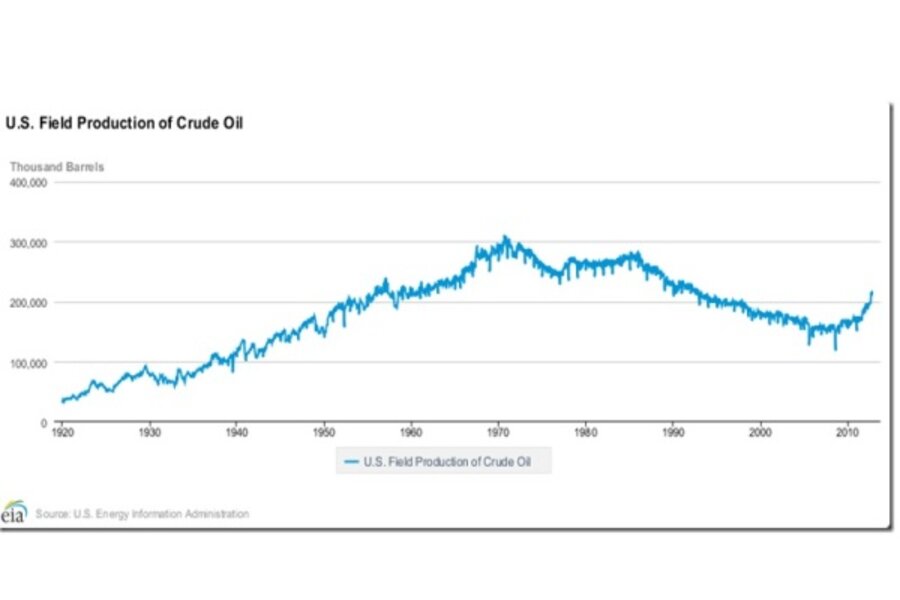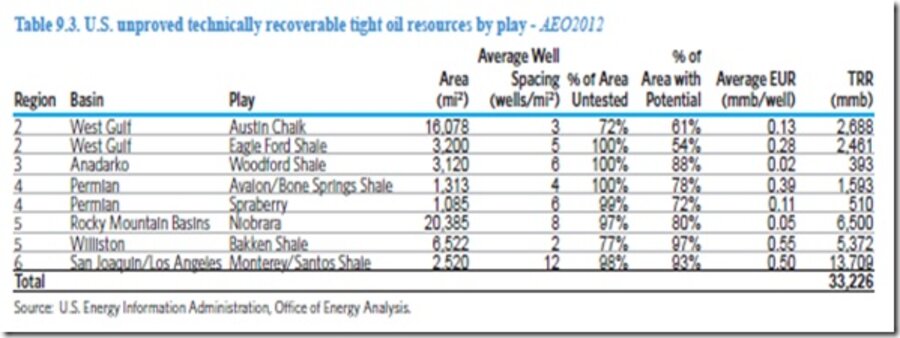US oil production: Don't believe the hype
Loading...
The way the oil industry is touting gains in U.S. crude oil production, you would think that production was soaring to new all-time highs. But the facts say otherwise. Above is a monthly production history through December 2012.
Production remains well below the peak achieved in 1970 and below a secondary peak—a lower high, if you will—which resulted from the ramp up of production in Alaska. But, as the graph shows, after that it was relentlessly downhill until just recently.
It is true that a new form of hydraulic fracturing—high-volume slick-water hydraulic fracturing—has made available sources of oil not previously accessible. But is it also true that the industry’s hyperbole doesn’t square with the evidence. The U.S. Energy Information Administration’s (EIA) latest estimate of technically recoverable oil from so-called tight oil deposits—the ones suitable for hydraulic fracturing—is 33 billion barrels (see below). It sounds like a lot. But, in fact, it would only supply the United States for about 6½ years. Not bad; but not a world-changing number, especially when you consider that all oil goes onto the worldwide market where that amount would last a little over a year.
But there is another column in the EIA chart above that is worth focusing on, the one labeled “% of Area Untested.” (Click on graphic above left.) We actually know every little about the potential for the country’s tight oil (often mistakenly referred to as shale oil). Many areas haven’t been drilled at all and in others drilling has only just begun. There is reason to believe that all may not go as planned since in areas already drilled, drillers have focused on a few sweet spots that have proven profitable. That just makes sense. But, it suggests that they must now venture beyond those sweet spots to find additional supplies from deposits that will be more stubborn and thus more expensive and difficult to exploit. No one is certain how drillers will fare. But logic suggests that production growth will slow and then stop at some point—and a decline will begin in earnest.
The EIA projects that U.S. oil production will peak later this decade—a little below the previous secondary peak in 1985. That would result in a tertiary peak, or yet another lower high. The extra supply in the meantime means that America will be spending less on imported oil. But the modest turnaround in America’s oil fortunes won’t solve the larger problem of worldwide oil depletion which, despite American gains, has kept worldwide oil production on a bumpy plateau since 2005.
We live in a worldwide oil market and that market remains tight as is evidenced by an oil price hovering around $90 in the United States and even higher in Europe where Brent Crude trades around $110 and is more representative of the world price.
For obvious reasons the oil industry doesn’t want us to think about weaning ourselves off oil anytime soon. They think if they can convince us that oil is abundant, we won’t even try. But oil prices have been telling us for almost a decade now that supplies are much tighter than the industry is acknowledging; and, the facts about American oil supplies tell us that if there is a revolution going on in U.S. oilfields, it is only a minor one and one that will soon be reversed. That doesn’t leave us much time to make preparations for a world in which oil supplies are almost certain to dwindle globally and last time I checked the United States is still located on planet Earth.








